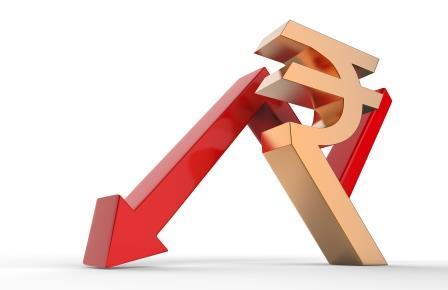
The Indian rupee has weakened to record lows, shedding more than 12 percent during the year, making it the worst performing Asian currency in 2018. Since the start of January, INR has weakened sharply from a two-and-half year high of Rs 63.28 versus dollar to its all-time low of Rs 72.91 due to various fundamental reasons.
Widening Current Account Deficit (CAD) and net capital outflows increased the demand for dollar resulting in rupee depreciation. A strong dollar coupled with the collapse in emerging market currencies and the escalation of global trade war affected the sentiments. CAD of the country widened to $15.8 billion or 2.4 percent of our GDP in the quarter ended June, the highest in four quarters.
Lately, many of the Emerging Market (EM) currencies have dropped sharply in the wake of Turkish and Argentinian currency crisis. Turkish Lira witnessed massive sell-off since the start of the year due to investor fears over the central bank’s independence and a diplomatic fight between the U.S and Turkish President Erdogan. Owing to political upheaval, a similar trend was seen in Argentinian peso as well. All these concerns took the MSCI’s emerging market currency index – the index measuring a basket of 26 currencies from emerging economies against the U.S dollar- to its lowest level since April 2017 recently.
MSCI Emerging market currency index
Performance of U.S dollar too affected the emerging market currencies. The U.S greenback has risen more than seven percent since the U.S Administration’s decision to impose tariffs on imports. Investors sought safety in dollar and pulled out of emerging market currencies on expectations of imposition of another round of tariffs on imports from China. Monetary tightening by the U.S Federal Reserve boosted the dollar as well. A bunch of recent upbeat economic releases from the U.S raised expectations of possibilities of further rate hike, which influenced the investor sentiment as well.
Rupee performance
The present decline in INR is not the worst considering its previous performances. Earlier, during the period of global financial crisis of 2008 Indian rupee had depreciated more than 24 percent. The financial crisis of 2008 is regarded as the worst financial crisis the world faced since the Great Depression of 1930s. The crisis initially originated in the U.S housing sector and eventually spread to all regions of the world. If we examine the last 10-year performance of INR, it has declined more than 80 percent so far.
INR Performance
Exchange rate fluctuations have considerable bearing on the economic health of a country and a deprecating currency will create ripple effects across various sectors of the economy. Exchange rate movements typically depend on demand and supply of the currency. Imports lead to outflows of foreign currency and exports bring in foreign currency. When imports are higher than exports, the dollar appreciates and INR depreciates. The weak currency will adversely affect the prices of commodities which are largely imported to the country. A weak local currency causes higher landed cost for imported goods and services in the country. Consequently, gold is traded firm domestically despite weakness in the international market.
Oil gained substantially due to higher import cost. On NYMEX, oil prices gained about 11 percent since the start of the financial year, while Indian rates surged to a four year high, gaining about 30 percent during the similar period, thanks to the weak currency. As against its international counterpart, extra gains were recorded in Indian natural gas prices as well.
Domestic gold prices held firm backed by weak Indian rupee. Though the benchmark London gold prices slid more than 12 percent since April, Indian prices were more or less steady due to weak local currency. This was due to a higher landed cost in rupee terms. During this period Indian rupee weakened from Rs 65 a dollar to Rs 72 a dollar. A similar trend has been seen in silver prices as well. Impact of weak currency was seen in the prices of internationally traded agriculture commodities like soybean, cotton, palm oil and rubber as well.
Impact of weak rupee on economy
Falling rupee increases the cost of imports and increases export revenues in rupee terms. Foreign capital inflows help in bridging the CAD. Despite strong economic growth, the weakness of INR is attributed to widening current account deficit due to higher crude oil prices. Our oil import bill increased more than fifty percent in the first four months of this financial year against the same period last year. Since the country imports more than 80% of its crude requirements, it is causing a huge outflow of foreign exchange.
Weak currency may result in inflationary pressure as well. High import cost of oil could translate into increased fuel cost and perhaps add to the overall cost of all economic activity. This may force the central bank to tweak monetary policy to tackle inflation. Recently, RBI raised interest rates by 50 basis points in two consecutive meetings, aiming to contain inflation. Higher inflation is likely to hit the short-term growth rate of the economy as well.
Weaker currency is likely to impact the profit margin of companies due to increased input cost. High import prices and increased local prices will add pressure to margins. Similarly, corporates may face higher interest costs if the central bank lifts rates. Additionally, this could impact the sentiments of foreign investors in the stock market. However, a weak rupee helps exporters. Indians working abroad may also gain substantially while remitting money to the country.
Anyhow, continued depreciation of currency will not benefit the country because it will have to pay more in local currency, keeping import bills high. Meanwhile, the RBI is likely to take steps for cooling down the currency volatility by appropriate market actions.